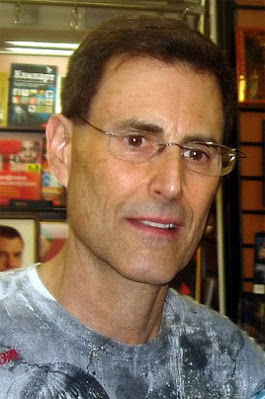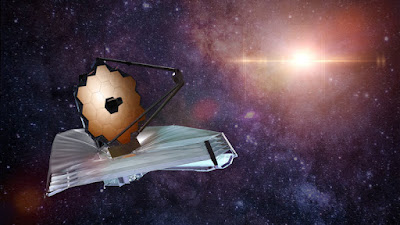It's been awhile since we've have a truly goofy claim to consider, so to take a brief diversion from more serious issues, today I bring you:
NASA space telescopes have
photographed the Celestial City of New Jerusalem, as hath been prophesied in the scriptures.
I wish I was making this up. The claim appeared on the ultra-fundamentalist site
Heaven & Hell, and the post, written by one Samuel M. Wanginjogu, reads like some kind of apocalyptic wet dream.
It opens with a bang. "Despite new repairs to the Hubble Telescope," Wanginjogu writes, "NASA refuses to release old photos or take new ones of Heaven!"
Imagine that.
He goes on to explain further:
Just days after space shuttle astronauts repaired the Hubble Space Telescope in mid December, the giant lens focused on a star cluster at the edge of the universe – and photographed heaven!
That’s the word from author and researcher Marcia Masson, who quoted highly placed NASA insiders as having said that the telescope beamed hundreds of photos back to the command center at Goddard Space Flight Center in Greenbelt, Md., on December 26.
The pictures clearly show a vast white city floating eerily in the blackness of space.
And the expert quoted NASA sources as saying that the city is definitely Heaven “because life as we know it couldn’t possibly exist in icy, airless space.
“This is it – this is the proof we’ve been waiting for,” Dr. Masson told reporters.
“Through an enormous stroke of luck, NASA aimed the Hubble Telescope at precisely the right place at precisely the right time to capture these images on film. I’m not particularly religious, but I don’t doubt that somebody or something influenced the decision to aim the telescope at that particular area of space.
“Was that someone or something God himself? Given the vastness of the universe, and all the places NASA could have targeted for study, that would certainly appear to be the case.”
Unsurprisingly, NASA researchers have "declined to comment."
Then we get to see the photograph in question:
After I stopped guffawing, I read further, and I was heartened to see that Wanginjogu is all about thinking critically regarding such claims:
I am not an expert in photography, but if you scrutinize the photo carefully, you find that the city is surrounded by stars if at all it was taken in space... If the photo is really a space photo, then it could most likely be the Celestial city of God because it is clear that what is in the photograph is not a star, a planet or any other known heavenly body.
Yes! Surrounded by stars, and not a planet! The only other possibility, I think you will agree, is that it is the Celestial City of God.
Wanginjogu then goes through some calculations to estimate the size of New Jerusalem:
If an aero plane [sic] passes overhead at night, you are able to see the light emitted by it. If that aero plane [sic] was to go higher up from the surface of the earth, eventually you won’t be able to see any light from it and that is only after moving a few kilometers up. This is because of its small size. Yet our eyes are able to see, without any aid, stars that are millions of light years away. This is because of their large size.
The further away an object is from the surface of the earth, then the bigger it needs to be and the more the light it needs to emit for it to be seen from earth.
The city of New Jerusalem is much smaller than most of the stars that you see on the sky. To be more precise, it is much smaller than our planet earth. Remember that here we are not talking of the entire heaven where God lives but of the City of New Jerusalem. The city of New Jerusalem is currently located in heaven. Of course, heaven is much larger that the city itself. The photo seems to be of the city itself rather than the entire heaven.
Some solid astrophysics, right there. He then goes on to use the Book of Revelation to figure out how big the city prophesied therein must be, and from all of this he deduces that the Celestial City must be somewhere within our Solar System for Hubble to have captured the photograph. He also uses the testimony of one Seneca Sodi, who apparently saw an angel and asked him how far away heaven was, and the angel said, "Not far."
So there you have it.
The best part, though, was when I got about halfway through, and I found out where Wanginjogu got the photograph from. (Hint: not NASA.) The photograph, and in fact the entire claim, originated in...
... wait for it...
...
The Weekly World News.
Yes, that hallowed purveyor of stories about Elvis sightings, alien abductions, and Kim Kardashian being pregnant with Bigfoot's baby. Even Wanginjogu seems to realize he's on shaky ground, here, and writes:
This magazine is known to exaggerate stories and to publish some really controversial articles. However, it also publishes some true stories. So we cannot trash this story just because it first appeared in The Weekly World News magazine. It is worthwhile to consider other aspects of the story.
He's right that you can't rule something out because of the source, but this pretty much amounts to something my dad used to say, to wit, "Even stopped clocks are right twice a day." But suffice it to say that here at
Skeptophilia headquarters we
have considered other aspects of the story, and it is our firmly-held opinion that to believe this requires that you have a single scoop of butter-brickle ice cream where the rest of us have a brain.
Anyway, there you are. NASA photographing heaven. Me, I'm waiting for them to turn the Hubble the other direction, and photograph hell. Since that's where I'm headed anyway, might as well take a look at the real estate ahead of time.
****************************************
The advancement of technology has opened up ethical questions we've never had to face before, and one of the most difficult is how to handle our sudden ability to edit the genome.
CRISPR-Cas9 is a system for doing what amounts to cut-and-paste editing of DNA, and since its discovery by Emmanuelle Charpentier and Jennifer Doudna, the technique has been refined and given pinpoint precision. (Charpentier and Doudna won the Nobel Prize in Chemistry last year for their role in developing CRISPR.)
Of course, it generates a host of questions that can be summed up by Ian Malcolm's quote in Jurassic Park, "Your scientists were so preoccupied with whether they could, they didn't stop to think if they should." If it became possible, should CRISPR be used to treat devastating diseases like cystic fibrosis and sickle-cell anemia? Most people, I think, would say yes. But what about disorders that are mere inconveniences -- like nearsightedness? What about cosmetic traits like hair and eye color?
What about intelligence, behavior, personality?
None of that has been accomplished yet, but it bears keeping in mind that ten years ago, the whole CRISPR gene-editing protocol would have seemed like fringe-y science fiction. We need to figure this stuff out now -- before it becomes reality.
This is the subject of bioethicist Henry Greely's new book, CRISPR People: The Science and Ethics of Editing Humans. It considers the thorny questions surrounding not just what we can do, or what we might one day be able to do, but what we should do.
And given how fast science fiction has become reality, it's a book everyone should read... soon.
[Note: if you purchase this book using the image/link below, part of the proceeds goes to support Skeptophilia!]




















